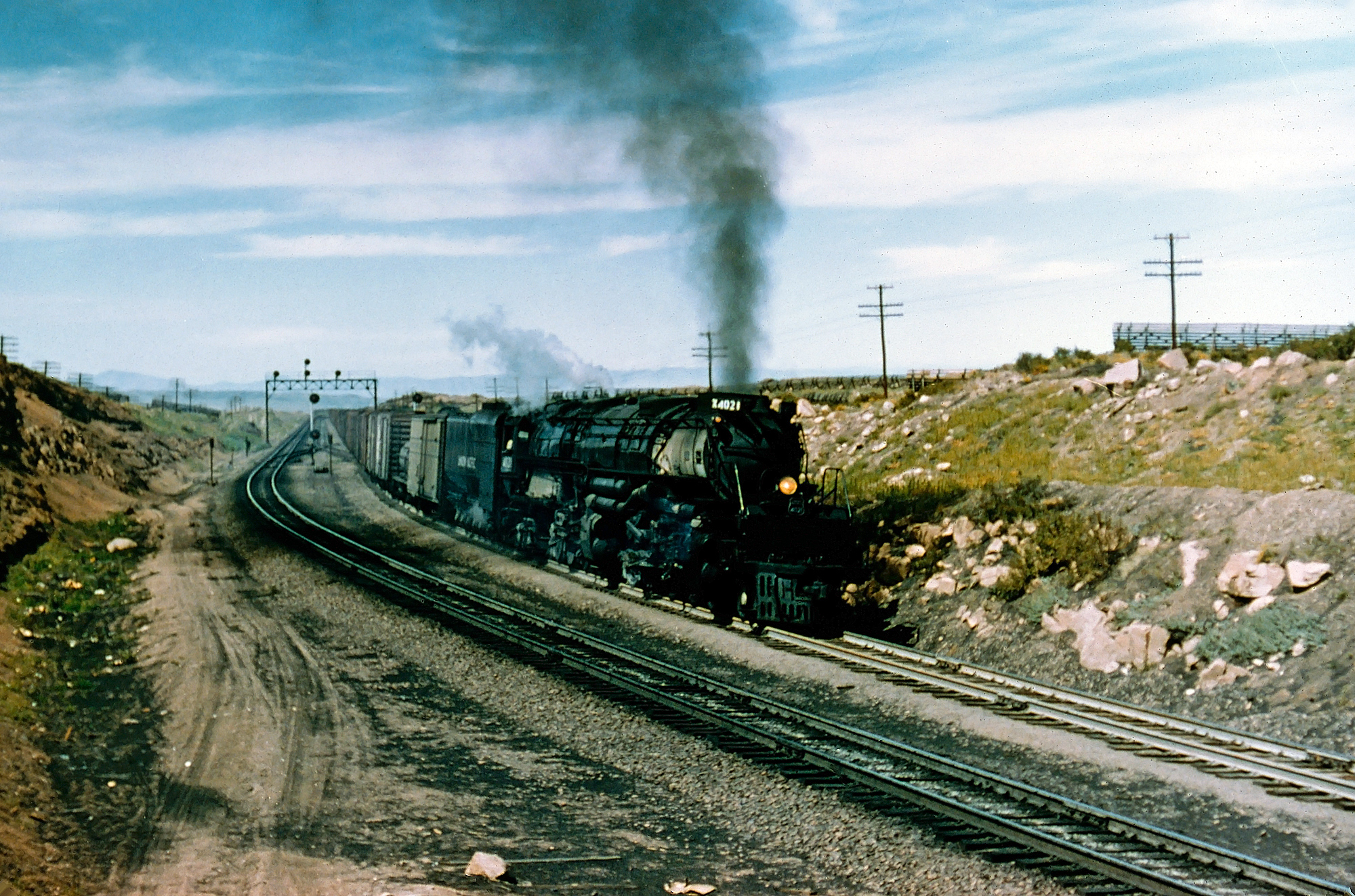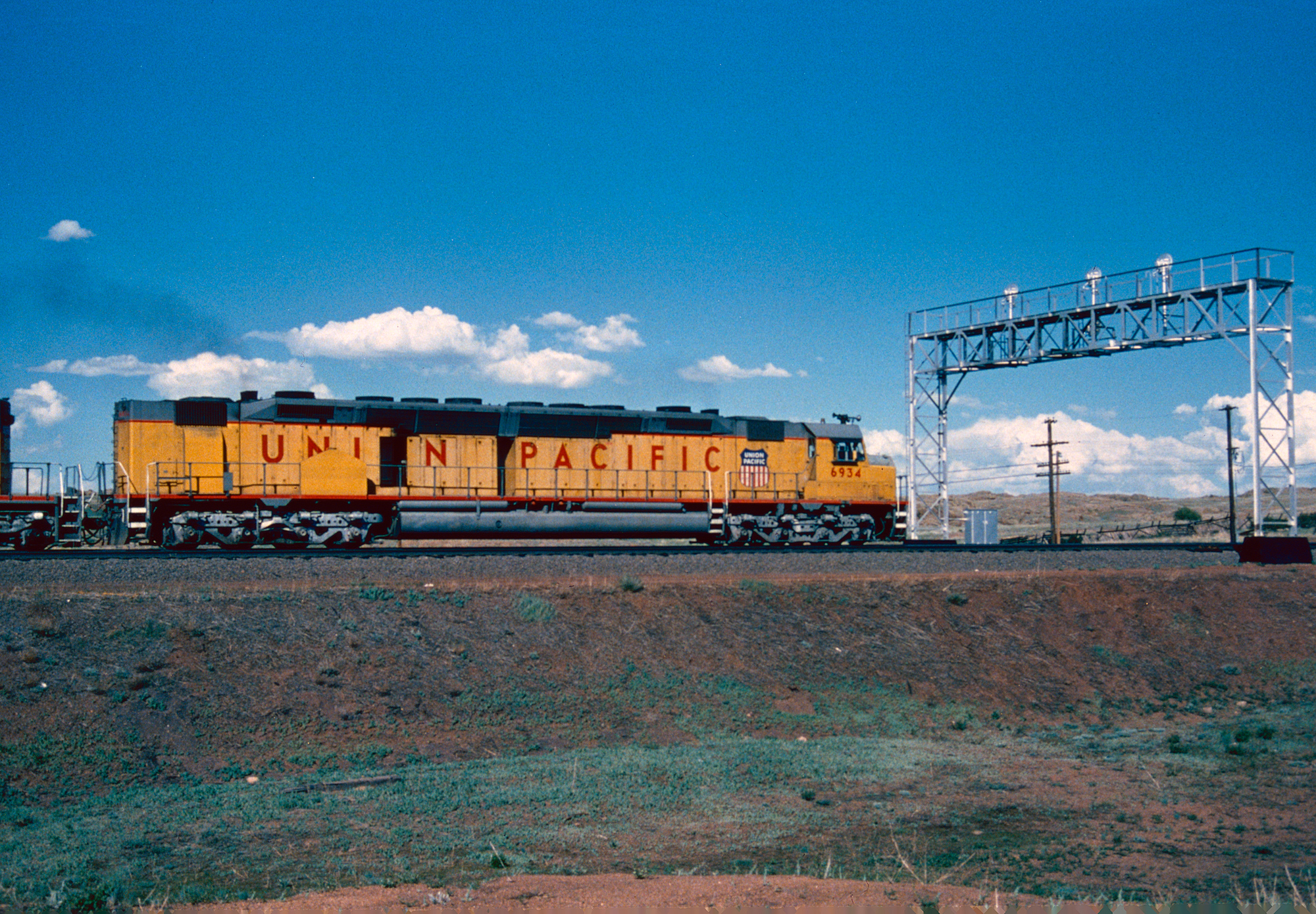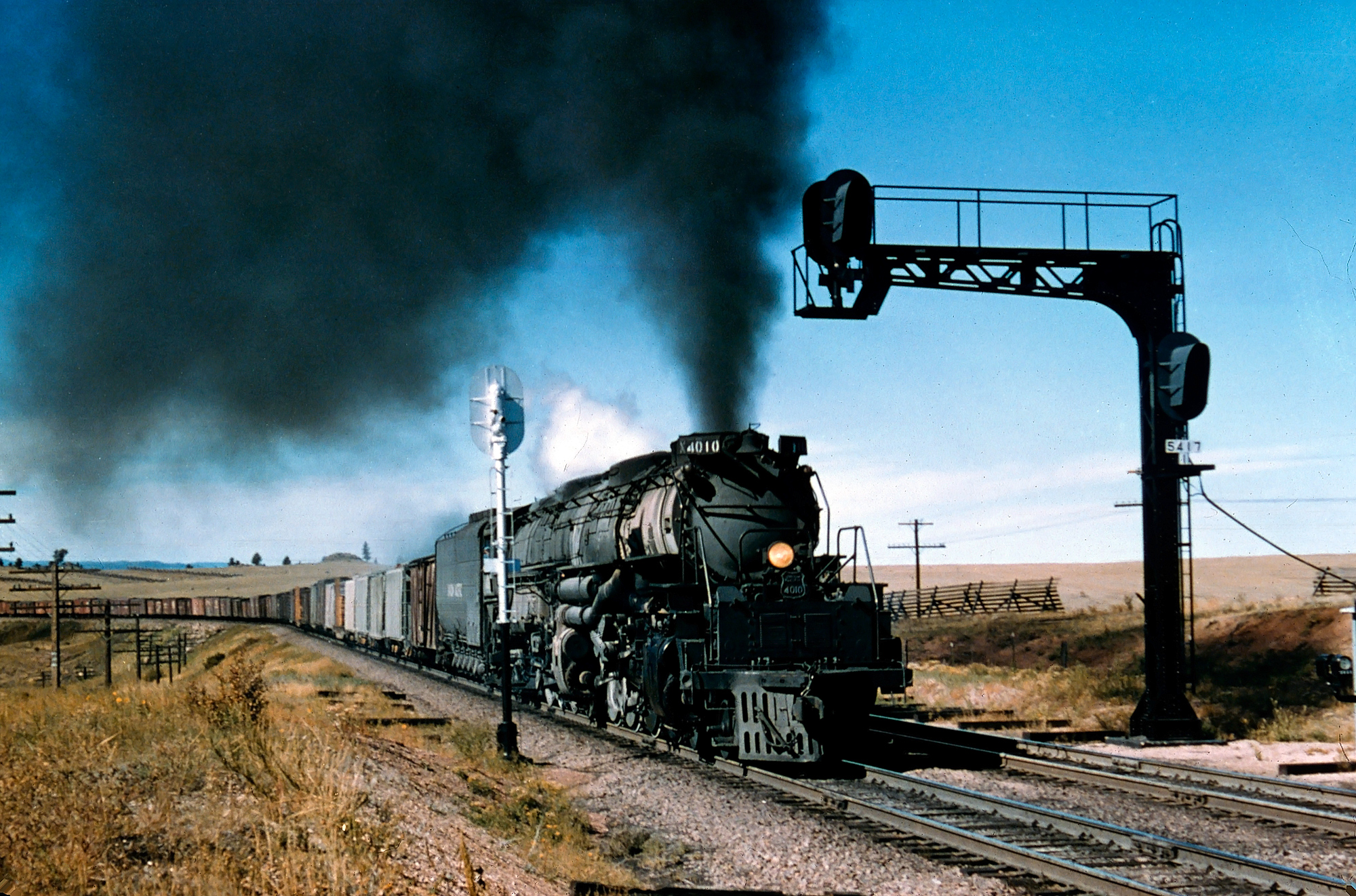Sherman Hill, Tackling Wyoming's Black Hills
Last revised: February 22, 2025
By: Adam Burns
At a summit of 8,014 feet, Union Pacific's original line over Sherman Hill was for years the highest point on the railroad.
Located in southeastern Wyoming, between Cheyenne and Laramie, it skirts the edge of the Black Hills and is a significant landmark in the history of westward expansion.
The hill has been a major obstacle not only in daily operation but also during the Transcontinental Railroad's construction. Engineering crews were forced to conceive innovative solutions to tackle this difficult terrain and a lay a manageable grade in reaching Laramie.
This section has always required the use of helpers although UP has worked to reduced this need when it constructed a new line in the early 1950s, known as the Harriman Cutoff, running times by 15 minutes.
Today, the railroad continues to battle the hill daily although the fight is no longer as daunting with modern locomotives like GE Evolutions and Electro-Motive/Progress Rail SD70 series units.
Photos
 Union Pacific "Big Boy" #4021 with an eastbound freight at Hermosa Tunnel on Sherman Hill (Wyoming); September 2, 1955. John Shaw photo. American-Rails.com collection.
Union Pacific "Big Boy" #4021 with an eastbound freight at Hermosa Tunnel on Sherman Hill (Wyoming); September 2, 1955. John Shaw photo. American-Rails.com collection.Original Line
Sherman Hill, an iconic high-altitude railroad route flanked by the majestic Rockies, elicits nostalgia and admiration in equal measure. An engineering marvel, it tells the tale of human perseverance and ingenuity.
The linchpin in the extensive rail network connecting Cheyenne and Laramie in the state of Wyoming, Sherman Hill has been in service since the Transcontinental Railroad's construction.
Union Pacific, a standard-bearer in the American railroad industry established in 1862, undertook this ambitious project steeped in rich history. Surveyors first came upon the location in 1865 as the railroad marched its way westward towards an eventual meeting with the Central Pacific.
Its completion can be traced back to 1868, a landmark year etched in the annals of American railroading. In his book, "The Men Who Built The Transcontinental Railroad: 1863-1869," author Stephen Ambrose notes track-laying crews building west from Cheyenne (a town established by Greenville Dodge in July, 1867) reached what was described as "Sherman Summit" (named for General William Tecumseh Sherman) in early April, 1868.
This original summit sat at an elevation of 8,242 feet, which at the time was the highest point of any railroad anywere in the world. Forging a rail line through the Black Hills (Laramie Mountains) was a daunting task that was as expensive as it was challenging.
Taking the mantle of the highest point on the First Transcontinental Railroad, Sherman Hill commands an astounding geographical prominence.
1901 Realignment
The line operated relatively unchanged until E.H. Harriman carried out the first realignment project in 1901. This project bypassed the original grade to "Sherman Summit" by opening a new route between Buford and Hermosa.
This section included Hermosa Tunnel and a new "Sherman" summit. Located between Buford and Dale it stood at an elevation of just 8,014 feet, more than 200 feet lower than the old grade.
As originally built, the line featured grades as severe as 1.92%. Following its completion, the maximum grade was reduced to 1.55% for westbound movements and 0.8% for eastbounds, which eliminated helpers on the latter.
The advent of increased traffic over Sherman Hill prompted the double-tracking of the line. The Harriman Cutoff largely completed the project except for a second bore of Hermosa Tunnel (completed in 1918) and the completion of Altamont Tunnel (completed on November 19, 1949).
Hermosa Tunnel is another spectacular nugget in the narrative of Sherman Hill. A vital part of the railroad line, this tunnel carved through the imposing mountains, stands 1,800 feet long and with enough height to facilitate the passage of double-stack intermodal trains.
 Union Pacific DDA40X "Centennial" #6934 leads an eastbound over Sherman Hill at Hermosa, Wyoming in the summer of 1985. American-Rails.com collection.
Union Pacific DDA40X "Centennial" #6934 leads an eastbound over Sherman Hill at Hermosa, Wyoming in the summer of 1985. American-Rails.com collection.1953 Improvements
In 1951 Union Pacific finally embarked on a second line improvement of the hill - in effect completing the project first began in 1901. The railroad's aim was largely to reduce the maximum gradient for westbound movements (1.55%).
What became known as the Harriman Cutoff required building 9.5 miles of new railroad. In their book, "Union Pacific Railroad" authors Joe Welsh and Kevin Holland note the $16 million project was contracted to Morrison-Knudsen.
The company employed 400 workers and utilized more than 100 pieces of heavy equipment to move 7 million cubic yards of dirt and rock in less than a year. To keep the new grade at 0.8% required several new cuts and fills.
Grading the line commenced on February 18, 1952 and tracklaying was carried out in July, 1952. All of this was finished on February 16, 1953 and the new cutoff opened to traffic on May 12, 1953.
Today
Despite the passage of time, the line over Sherman Hill has not lost its relevance, continuing to be a critical artery for UP today. As a lifeline of transportation, it retains its significance as the highest point on the Union Pacific system and a bustling trade route.
Today, the line through Sherman Hill sees an intense volume of traffic, more than a century after its creation. It is reported that the line sees upwards of 100 trains on any given day, underlining its central role in the transcontinental railroad system.
As history merges into the present, Sherman Hill continues to pose an operating challenge due to its rugged terrain and harsh weather. However, it is the same challenge that adds a sense of accomplishment to the trains thundering over Sherman Hill, an enduring symbol of American railroad heritage.
Promising breathtaking vistas, the train journey up Sherman Hill is an immersive experience. As the trains ascend, the spectacle of plunging valleys and towering peaks unfolds, making up for the arduous climb with an unrivaled panoramic view.
Despite the trials presented by Mother Nature, human determination triumphed in the form of Sherman Hill. It is a testament to the possibilities that can be unlocked when indomitable spirit is backed by innovative engineering solutions.
The dawn of diesel locomotives in the mid-20th century bestowed a renewed operational advantage on the line over Sherman Hill. The advent of these powerful machines escalated the traffic over this high-altitude route.
Steeped in rich history, the spectral presence of the Transcontinental Railroad looms over Sherman Hill. As a critical juncture in the transcontinental route, this stretch symbolizes a pivotal chapter in the narrative of American railroading.
Each train surmounting Sherman Hill is a moving testament to Union Pacific's unwavering commitment towards conquering geographical challenges. This commitment continues to echo in the raging symphony of the steel wheels rolling over the rails.
The modern narrative of Sherman Hill is punctuated with the rhythmic cadence of both freight and passenger trains. The freight trains, often pulled by powerful multi-engine units, transport goods across the continent, underscoring Sherman Hill's importance in the national economy.
Not just a vital cog in the national goods transportation network, the line also serves as a spectator's paradise. The relentless chugging of trains climbing the daunting incline against the backdrop of the Rocky Mountains is a sight to behold for onlookers.
With the Sherman Hill model train show held annually in Cheyenne, the Union Pacific has ensured that this iconic stretch lives on, not just on the physical landscape, but in miniature railroads, captivating train enthusiasts with a vivid reproduction of this unique railroad scenario.
Sherman Hill is continually adapting to the evolving needs of the American rail network. With the line well into its second century of operation, it continues to bask in the glory of being a beacon of American railroading in the Rocky Mountains.
Witnessing a parade of massive trains tackling the steep grades, it is evident that the story of Sherman Hill is still being written. As each train conquers the rugged terrain and freezing temperatures, it adds another page to the epic tale of this monumental railroad.
Legacy
Sherman Hill stands as an enduring testament to the spirit that propelled the creation of the Transcontinental Railroad. The dust-laden wind sweeping over the tracks seems to whisper tales of the men who, against all odds, carved out this path through the Rockies.
From steam engines like the massive 4-8-8-4 "Big Boys" hissing their dominance over the steep grades to diesel-powered behemoths such as the DD35A and DDA40X rumbling past, Sherman Hill has played host to the evolution of rail technology. It continues to embrace progress, staying in sync with the pulse of American railroading.
Union Pacific takes great pride in its Sherman Hill line, a historic asset that reflects the organization's ethos of embracing challenges. The railroad has assignment its flagship steam program locomotives to operate over the line, including 4-8-4 #844, 4-6-6-4 #3985, and 4-8-8-4 #4014.
As the trains continue their relentless march over the Hill, Union Pacific can take solace in knowing that its vital artery is immortalized in history. Their journey salutes the men and machines behind the monumental construction and operation of this ambitious rail line.
Each moment on Sherman Hill finds itself etched in the annals of American railroading. As the sun sets on this rugged landscape, the silhouette of the snaking trains against the mountains epitomizes the American spirit of conquering challenges.
Generations of railroaders and engineers have been charmed by the allure of Sherman Hill. As one of the loftiest and toughest railroad passages in North America, it has rightfully earned its place in the annals of railroading folklore.
 Union Pacific 4-8-8-4 "Big Boy" #4010 leads an eastbound over Sherman Hill (Wyoming) on the afternoon of September 7, 1956. John Shaw photo. American-Rails.com collection.
Union Pacific 4-8-8-4 "Big Boy" #4010 leads an eastbound over Sherman Hill (Wyoming) on the afternoon of September 7, 1956. John Shaw photo. American-Rails.com collection.Sherman Hill is a testament to human determination and endurance. It remains a symbol of how far we've come, and a reminder of the challenges we have the strength to overcome, mirroring the ethos of the Transcontinental Railroad that sought to bind the nation.
Sherman Hill’s illustrious past and promising future aptly sum up its timeless allure, earning it a distinct place in both historical and contemporary American railroad landscape. This slight stretch of rail over a mountain in Wyoming continues to remain not just a conduit for trains, but a pathway through time, a custodian of countless tales of human perseverance and technological triumph.
Recent Articles
-
Oregon Railroad Museums: A Complete Guide
Apr 25, 25 03:11 PM
With its rich tapestry of scenic landscapes and profound historical significance, Oregon possesses several railroad museums that offer insights into the state’s transportation heritage. -
North Carolina Railroad Museums: A Complete Guide
Apr 25, 25 02:56 PM
Today, several museums in North Caorlina preserve its illustrious past, offering visitors a glimpse into the world of railroads with artifacts, model trains, and historic locomotives. -
New Jersey Railroad Museums: A Complete Guide
Apr 25, 25 11:48 AM
New Jersey offers a fascinating glimpse into its railroad legacy through its well-preserved museums found throughout the state.

